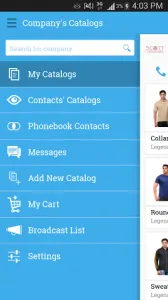NextGen Catalogs Offers Key Solutions For Businesses to Hold onto Customers
WireddIn, an IIT Bombay alumni start up, are gearing up for their latest offering to the world, NextGenCatalogs. A mobile platform that helps Indian SME’s sustain their customer relationships, it aims to solve a crucial problem that exists in the market. Vikram Parekh, one of the directors, talks to Your Story about the new product, why it was launched, initial hiccups and future plans.

Tell us about NextGenCatalogs
NextGenCatalogs is a B2B mobile platform where users can create product catalogues, integrate them with their customers’ phone book, and have product-centric conversations.
NextGenCatalogs helps product manufacturers, distributors, and retailers to stay on the same page (quite literally). A small and medium business owner, who frequently updates their product portfolio, and has the need for continuous engagement with existing customers, will find NextGenCatalogs a perfect fit for their product marketing, and customer support needs.
What inspired you to launch NextGenCatalogs?
WireddIn Interactive Pvt. Ltd. is an IIT-Bombay alumni startup founded on 30 Oct 2012 in Mumbai, by Aaron Dsouza, Gaurav Toshniwal and Vishal Shah, and later joined by myself (Vikram Parekh) in Sept 2013. We started out as a services business by providing mobile and web solutions to marquee clients across multiple industries, and have now fully transitioned into a product business. Some of our services projects can be seen on www.wiredd.in
We’re currently a 12 member team with a good mix of both technical and business skills.
The genesis of NextGenCatalogs lies in one of the services project we did for a garments manufacturer in Indore. We created an iOS app to help him map his supply chain onto a single platform. Using the app, he was able to upload his product catalogs, keep his distributors updated, and provide them with them ability to place and track orders. Key benefits to him included improved existing customer relationships, increased repeat business, and improved business efficiency.
What problem does NextGenCatalogs solve?

We tested this use case across multiple industries, and with over 100 manufacturers, distributors and retailers, and noticed that a significant number of Indian SMEs faced a similar issue when it came to sustaining their existing customer relationships and better marketing their products.
While Discoverability (how can people find me) was getting solved via existing B2B marketplaces, Sustainability (how do I keep my existing customers engaged), was a big issue.
Today SMEs use traditional ways of marketing including email marketing, SMS marketing, online ads etc, and soon realize that the ROI on such spend is extremely low, even after putting a lot of effort. Their existing customers are always on the move, need access to information on their fingertips, and are used to interacting while on the go, and hence having a mobile first solution was the need of the hour.
This is the need gap that NextGenCatalogs is trying to address.
How big is your market?
As per Zinnov, in 2013 India had 50M SMEs of which only 0.5M had a websites. This along with the exponential growth in both mobile usage, internet penetration, and 15% CAGR on IT adoption in SMEs, we strongly believe we have a large gap to fill.
More than anywhere else, B2B SME businesses are built on strong long term relationships. With NextGenCatalogs, our users can leverage the power of product centric conversations, push notifications, and a structured view of product catalogs to reach out to their existing business network.
What were your challenges initially? How did you tackle them?

We launched the product on Feb 24, 2014, and since then have learnt a lot from existing customer feedback. Some of the challenges included, making the UI more intuitive, onboarding the first set of customers and explaining them the value proposition.
We are currently testing various sales & marketing strategies on how best to reach out to this unorganized and highly fragmented Indian SME diaspora. We believe it’ll be still another few months until we get it right on what works and what doesn’t.
Who are your competitors, and how are you different from others in the same space?
We define competition from a customer’s perspective and how he’s currently addressing his need for customer engagement and product marketing. Hence, it can be broken down into:
Existing CRM tools - Our differentiation: Mobile first, easy to use, lean and fit-for-purpose
Existing Email/SMS/Web marketing - Our differentiation: Better ROI, Push Notifications
Existing Chat tools - More structured, privacy controlled, product centric conversations. In future, ability to make it an open platform with ability to integrate with other tools using APIs.
Existing B2B Listing Services - Our differentiation: Ability to continue the relationship once a new customer has found you.
How have you been funding your start up?
We’ve been self-funded through internal accruals and external investment by me. We’re now actively seeking for investments, and have initiated conversations with some Angels and VCs.
How do you see your start up evolving in the coming days?
From the ground up, NextGenCatalogs is built as a global product. Our long term vision to prove the business model here in India, and potentially look at similar markets globally.
In the near term, from a product perspective, our focus is to give customers the ability to create catalogs directly from your mobile, enable push notification marketing, and launch across other mobile platforms.
From a customer perspective, as the market is quite unorganized and fragmented, we’re aggressively working to form strategic partnerships to help us penetrate deeper in Tier 2 and Tier 3 cities in India, and across multiple industries.
Our goal is to reach out to as many SMEs in India as possible. We’re looking to sign up at least 10,000 users in the first year.







